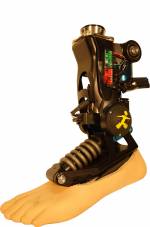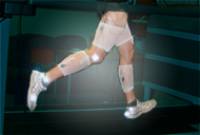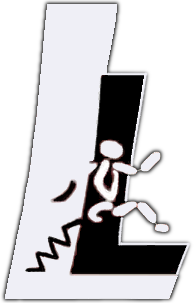Research projects of the Lauflabor Locomotion Laboratory

WhiteBox: Erklärbare Modelle für menschliche und künstliche Intelligenz (Explainable models for human and artificial intelligence) (2021 - 2025)
Funding: LOEWE-Schwerpunktantrag, granted by the Hessisches Ministerium für Wissenschaft und Kunst from 1. 2021 to 12.2024
Consortium: Nine academic partners from different departments of TU Darmstadt are involved in this project. You can see details here,
The LOEWE Research Cluster WhiteBox is aimed at developing methods at the intersection between Cognitive Science and AI to make human and artificial intelligence more understandable. Lauflabor group Leads WP3.1 „Man and Machine walk together“ in this project. Here we develop the bioinspired models of human gait and connect them to robot models. The focus of our research will be on developing white box biomechanical models of human locomotion and motor control to be integrated with the black-box (learning-based) models for robot control to improve our understanding of locomotion control in humans and robots. This could be later used to develop bioinspired robots and assistive devices.
For grasping more insights about the project and Lauflabor's contribution please Read more...
EPA-2: Integrating Locomotor Subfunctions with Electric-Pneumatic Actuation (2021 - 2024)
Funded by DFG
 Compared to biological muscles, current technical actuators are limited in their performance and versatility to realize human-like locomotion. For resolving this problem we need to better understand biological legged locomotion which can be described in a three-level structure: 1) generation of the different locomotor subfunctions (LSF), namely stance, swing, and balance, 2) composition of LSFs for versatile legged locomotion and 3) LSF adaptation for various locomotion tasks and conditions.
Compared to biological muscles, current technical actuators are limited in their performance and versatility to realize human-like locomotion. For resolving this problem we need to better understand biological legged locomotion which can be described in a three-level structure: 1) generation of the different locomotor subfunctions (LSF), namely stance, swing, and balance, 2) composition of LSFs for versatile legged locomotion and 3) LSF adaptation for various locomotion tasks and conditions.
In order to overcome the actuator limitations for locomotion, we recently introduced the hybrid EPA actuator as a combination of electric and pneumatic actuators. The EPA design provides direct access to the control and morphological properties. We recently demonstrated that with the EPA, the actuator limitations could be clearly reduced for stance LSF in vertical hopping.
In this follow-up project, we will explore the full potential of the EPA approach by extending its application to versatile locomotion following the above-mentioned three levels.
In this project, a collaboration with HOSODA Lab in the University of OSAKA, PoWeR Lab from Georgia Tech and Biorobotic lab from TU Delft Biorobotic lab from TU Delft is foreseen.
Contact: Ph.D. Maziar Sharbafi
Better balance and reduced risk of falling through contactless coupling of vibrations (2019 - 2021)
The daily number of falls is increasing with increasing age and due to balance influencing impairments. In order to reduce the related number of falls and fall-related deaths, mainly physical training interventions were investigated so far. In this collaborative project, we investigate the application of air-coupled ultrasound vibrations during human locomotion as means to restore balance capabilities and improve balance. The interdisciplinary project is performed in collaboration with the Measurement and Sensor Technology Group (MuST) in the Electrical Engineering Department and founded by the Forum for Interdisciplinary Research. Please see the Project Page for further information.
Contact: Dr. Martin Grimmer, Dr. Christian Schumacher, Dr. Guoping Zhao
Improving walking assistance techniques for lower limb exoskeletons (2019 - 2023)
Many people suffer from limited mobility due to aging or diseases. Lower limb exoskeletons seem to be solution to overcome part of these limitations. With the help of the Athene Young Investigator funding an existing exoskeleton simulator, which is used to manipulate human movement, should be improved and used to investigate hardware and control solutions to assist walking gait. Each actuation unit of the simulator consists of a motor, a pulley and a bowden cable that is attached to the human by a hip human-machine interface. Each actuation unit can manipulate one degree of freedom in one direction and is placed offboard behind the treadmill. It is planned to investigate on online optimization techniques for walking assistance. First evaluations should be performed with healthy young subjects.
Contact: Ph.D. Martin Grimmer Ph.D. Guoping Zhao
Robust phase-based control of prosthetic feet and biologically inspired joint coupling (2018 - 2021)
 Human locomotion is the outcome of a complex and fascinating interaction between body mechanics, actuator dynamics and the neural control system. In the case of lower limb loss, amputees suffer from reduced functionality and limited power generation of their passive prosthetic limbs. To overcome such limitations, in recent years, researchers have developed powered prostheses to emulate the joint motions similar to able-bodied people.
Human locomotion is the outcome of a complex and fascinating interaction between body mechanics, actuator dynamics and the neural control system. In the case of lower limb loss, amputees suffer from reduced functionality and limited power generation of their passive prosthetic limbs. To overcome such limitations, in recent years, researchers have developed powered prostheses to emulate the joint motions similar to able-bodied people.
Current studies show that powered prosthetic can reproduce natural human ankle range of motion and power in walking and running. Regarding the control of prosthetic feet further research is necessary in order to be able to recognize and support as many situations in everyday live as possible.
Phase based controls are considered particularly robust control approaches for powered prosthetic feet. They rely on invariant trajectories of human locomotion, from which an invertible relation between the user’s states and gait phase is derived. The gait phase can then be used to compute reference signals for the actuators. Hence phase based approaches can react on irregular movements and changing gait parameters. Phase based approaches for powered prosthetic feet exist for standing, level walking and running. The first aim of this research project is the development of a phase based controller which includes standing and level walking as well as stair climbing and safe transitions between these motion types. Human experiments on an instrumented stairway will provide required input data for the envisioned controller.
A recent study with the BiOM prosthetic foot (iWalk) show that, despite improvements in the ankle, increased stress and asymmetry remains in proximal joints. The authors argue that the restoration of normal gait kinematics and kinetics was not possible using the active foot due to the uni-articulation (mono-articulation) of the device. Bi-articular coupling exists for humans through the gastrocnemius muscle, but is not taken into account in the implementation of current prosthetic feet.
Thus, in addition to the phase-based control, the second aim of this project is to design a prototype for a new bionically inspired prosthesis, which, in addition to the mono-articular soleus muscle, also features the function of the biarticular gastrocnemius muscle. The concept is more consistent with the biological leg than existing monoarticular prostheses. The new prototype shall be used to obtain best possible gait for level walking and running. Therefore, only experiments with constant speeds will considered and focus will be placed on determination and application of optimal actuator forces.
Contact: Ph.D. Martin Grimmer
Generating human walking gait with a neuromuscular model based on deep reinforcement learning (2018 - 2019)
A gait model capable of generating human-like walking behavior at both the kinematic and the muscular level can be a very useful framework for developing control schemes for humanoids and wearable robots such as exoskeletons and prostheses. In this work we are aiming at demonstrating the feasibility of using deep reinforcement learning based approach for neuromuscular gait modelling. A lower limb gait model consists of seven segments, fourteen degrees of freedom, and twenty two Hill-type muscles was built to capture human leg dynamics and the characteristics of muscle properties. We implemented the proximal policy optimization algorithm to learn the sensory-motor mappings (control policy) and generate human-like walking behavior for the model. Human motion capture data, muscle activation patterns and metabolic cost estimation were included in the reward function for training.
Contact: Dr. Guoping Zhao
Hybrid Electric-Pneumatic Actuator (EPA) for legged locomotion (2017 - 2021)
Funded by DFG A better understanding of how actuator design supports locomotor function may help design and develop novel and more functional powered assistive or robotic legged systems. Legged locomotion can be described as a composition of locomotor sub-functions, namely axial leg function, leg swinging and balancing. In this project, we focus on the axial leg function (e.g., spring-like hopping) based on a novel concept of a hybrid electric-pneumatic actuator (EPA). This principal locomotor sub-function determines the movement of the body center of mass. We will design and manufacture EPA prototypes as enhanced variable impedance actuators (VIA). In contrast to other VIAs, the EPA provides not only adaptable compliance (e.g. an adjustable spring) but with the pneumatic artificial muscle (PAM) also an additional powerful actuator with muscle-like properties, which can be arranged in different configurations (e.g., in series or parallel) to the electric motor (EM). This novel hybrid actuator shares the advantages of EM and PAM combining precise control with compliant energy storage required for efficient, robust and versatile human-like leg motions via simple control laws.
Contact: Ph.D. Maziar Sharbafi
Optimized measurement, adjustment, and manufacturing of lower limb prosthetic sockets (2015 - 2018)
Funded by AiF/IGF: 18873 N/2
 In an interdisciplinary project funded by AiF in cooperation with two institutes of the TU Darmstadt ( Psychology and Mechanical Engineering) and the Biomechatronics Group of the Fraunhofer IPA in Stuttgart, we are working on the idea of elaborating the way in which prosthetic sockets are fitted: evolving from handicraft to a semi-automatic development method. Using experimental trials, modeling approaches, the expertise of outstanding orthopedic technicians and the subjective feedback given by amputees, we want to objectify the fitting process and develop a method which decreases fitting time and iterations while reducing the dependence on the technician’s expertise.
In an interdisciplinary project funded by AiF in cooperation with two institutes of the TU Darmstadt ( Psychology and Mechanical Engineering) and the Biomechatronics Group of the Fraunhofer IPA in Stuttgart, we are working on the idea of elaborating the way in which prosthetic sockets are fitted: evolving from handicraft to a semi-automatic development method. Using experimental trials, modeling approaches, the expertise of outstanding orthopedic technicians and the subjective feedback given by amputees, we want to objectify the fitting process and develop a method which decreases fitting time and iterations while reducing the dependence on the technician’s expertise.
Contact: M.Sc. Christian Schumacher
Human-induced vibrations on building structures (2015 - 2016)
In this project, we will investigate and characterize human-structure interaction from two different perspectives — biomechanics and structural mechanics.
In daily activities (e.g. walking, jogging) we often encounter such circumstances that we traverse an area with different ground properties. In such cases our body has to manage the resulting change in external forces in order to adapt to the change in surface stiffness. In order to synchronize the gait and accommodate the changes in the environment during human locomotion, we need a comprehensive understanding of the underlying principles of system identification and adaptation mechanisms. The biomechanical approach is to develop concepts of the adaptation strategies based on experimental findings from human locomotion. The concepts will be translated into computer simulation models. We expect to better understand how the design of a biological body allows for an efficient and robust passive control to cope with the changes in locomotion.
Modular Orthopedic Means with Robust EMG and Force Sensing (MorHRoSe) (2014 - 2015)
Funded by LOEWE; HA project no. 436/14-26
Modern assistive technology (e.g. Exoskeletons, Orthoses) are getting more and more advanced. Still they face challenges in means of control by the intention of the user. EMG and Force Sensing can be used to detect the target motion of a user by sensing his/her muscle activation or contact forces. This interdisciplinary LOEWE SME Integrated Project aims at developing a more elaborated and robust sensor technology for application in Orthoses. Project Partners are the Simulation, Systems Optimization and Robotics Group (SIM) of the TU Darmstadt and Evosense.
Contact: M.Sc. Christian Schumacher

Balance (2013 - 2017)

The Balance Project is a interdisciplinary project funded by the European Union. It aims at creating an exoskeleton that providesbalance support for humans. BALANCE, or more precisely B.A.L.A.N.C.E. is an acronym for Balance Augmentation in Locomotion, through Anticipative, Natural and Cooperative control of Exoskeletons.
There are four main fields of research in this project: Experiments with healthy subjects, biomechanical modelling, control design and hardware design of an improved exoskeleton.
At the Lauflabor, we will focus on biomechanical modelling in order to (a) understand how humans achieve and maintain balance in experiments, and (b) provide these models as basis for a control design to our project partners.
PAKO - Powered Ankle Knee Orthoprosthesis (2009 - 2015)
 The PAKO project is a project on human gait funded by the DFG - German Science Foundation. It addresses two basic aims using a prosthetic platform. A first background is to understand difficulties in current prosthetic technology and to develop new concepts for improvements. A second background is to use prosthetics as a model applied to a human. By this method it is possible to use still existing physical abilities for stability or hip actuation and to reduce applied hardware model complexity to a minimum. As a result it is easier to evaluate the function of different biological structures like muscles or tendons.
The PAKO project is a project on human gait funded by the DFG - German Science Foundation. It addresses two basic aims using a prosthetic platform. A first background is to understand difficulties in current prosthetic technology and to develop new concepts for improvements. A second background is to use prosthetics as a model applied to a human. By this method it is possible to use still existing physical abilities for stability or hip actuation and to reduce applied hardware model complexity to a minimum. As a result it is easier to evaluate the function of different biological structures like muscles or tendons.
Walk-Run Ankle Prosthesis (2012 - 2016)

The Walk-Run Ankle is a powered prosthesis for foot replacement designed by Springactive (US). It was designed in a research project supported by the Eunice Kennedy Shriver National Institute of Child Health & Human Development of the National Institutes of Health under award number R43HD072402. The design was made to investigate on powered amputee walking and running. As similar topics were adressed in the PAKO project (SE1042/8) a colaboration between the Lauflabor and Springactive led to a controller development for the powered ankle that is able to change gait independent from speed depending on user intention.
BioBiped (2009 - 2014)
 The BioBiped project is funded by the DFG - German Science Foundation. It aims at realizing human-like three-dimensional running, walking and standing and herewith allowing the free selection of speed and gait. For achieving this goal, the SIM Group of TU Darmstadt and the Locomotion Laboratory of TU Darmstadt cooperate in this project.
The BioBiped project is funded by the DFG - German Science Foundation. It aims at realizing human-like three-dimensional running, walking and standing and herewith allowing the free selection of speed and gait. For achieving this goal, the SIM Group of TU Darmstadt and the Locomotion Laboratory of TU Darmstadt cooperate in this project.
Integration of biomechanics research in the concept of the development of versatile, robust and energy-efficient bipedal robots may represent an essential tool to get a step closer to robots with human-like locomotion capabilities.
Locomorph (2009 - 2013)
 The Locomorph project is funded by the European Union. It aims to develop a framework for robust and multifunctional legged robots. Some novel experiments with humans and animals will be accomplished in the Lauflabor bringing morphology to light.
The Locomorph project is funded by the European Union. It aims to develop a framework for robust and multifunctional legged robots. Some novel experiments with humans and animals will be accomplished in the Lauflabor bringing morphology to light.
General Leg Control - Generalisierte Beinkontrolle (2009 - 2011)
 In this project the translation of simple conceptual gait models into segmented leg models is addressed. With body segmentation, lumped leg parameters (e.g., leg length, leg angle and leg stiffness) become a function of joint properties (e.g., joint angles, joint stiffness) and segment properties (e.g. segment lengths). These mechanical and geometrical dependencies are challenging but also offer new perspectives into design and control of legged systems.
In this project the translation of simple conceptual gait models into segmented leg models is addressed. With body segmentation, lumped leg parameters (e.g., leg length, leg angle and leg stiffness) become a function of joint properties (e.g., joint angles, joint stiffness) and segment properties (e.g. segment lengths). These mechanical and geometrical dependencies are challenging but also offer new perspectives into design and control of legged systems.
Runbot - FoxRobot (2008 - 2012)
 This robotic project is funded by the Kolleg der Studienstiftung des deutschen Volkes. It aims at the understanding of human gait and gait control. As a basement a redesign of the Runbot robot is used. Originally it was developed at the Bernstein Center for Computational Neuroscience in Göttingen. In the new version the Fox robot feet design was changed including elastic elements to improve gait performance.
This robotic project is funded by the Kolleg der Studienstiftung des deutschen Volkes. It aims at the understanding of human gait and gait control. As a basement a redesign of the Runbot robot is used. Originally it was developed at the Bernstein Center for Computational Neuroscience in Göttingen. In the new version the Fox robot feet design was changed including elastic elements to improve gait performance.
Marco Hopper (since 2005)
 The Marco Hopper project is funded by the DFG - German Science Foundation. In this project we identify mechanisms required for stable hopping motion based on experiments with robots, and humans as well as templates. Herefore, we investigate muscle reflexes and preflexes at joint level but also global strategies, e.g. stiffness adjustment of the leg. With the Marco hopper we have the chance to clearly understand the requirements for real world hopping motions in the case of absent elasticity. In a robot it is necessary to implement for instance energy and impact management. These important aspects are focus of this project.
The Marco Hopper project is funded by the DFG - German Science Foundation. In this project we identify mechanisms required for stable hopping motion based on experiments with robots, and humans as well as templates. Herefore, we investigate muscle reflexes and preflexes at joint level but also global strategies, e.g. stiffness adjustment of the leg. With the Marco hopper we have the chance to clearly understand the requirements for real world hopping motions in the case of absent elasticity. In a robot it is necessary to implement for instance energy and impact management. These important aspects are focus of this project.
Research within the Emmy Noether Program (2003 - 2010)
Human Gait
 To improve basic mechanical understanding of human gait, investigations are taken from modelling center of mass dynamics to the embedment of segments and joints. Following this approach, first focus lies on how different joint kinematics in a human three-segmented leg allow for compliant leg behaviour in both gaits. Characterizing joint properties as well as linkage to muscle mechanics and coordination are further steps.
To improve basic mechanical understanding of human gait, investigations are taken from modelling center of mass dynamics to the embedment of segments and joints. Following this approach, first focus lies on how different joint kinematics in a human three-segmented leg allow for compliant leg behaviour in both gaits. Characterizing joint properties as well as linkage to muscle mechanics and coordination are further steps.
Gait Stability
 Stability is a major key in running and walking. In this project we investigate on how design elements of legs influence bipedal gaits. Furthermore, we identify swing-leg strategies to improve gait stability.
Stability is a major key in running and walking. In this project we investigate on how design elements of legs influence bipedal gaits. Furthermore, we identify swing-leg strategies to improve gait stability.
Bipedal Robots

Physical models raise questions that computer-models do not pose. In this project experimental biomechanical findings, neural control concepts and computational model predictions are biomimetically translated into robots to proof concepts, raise new questions and to better understand human leg function.






